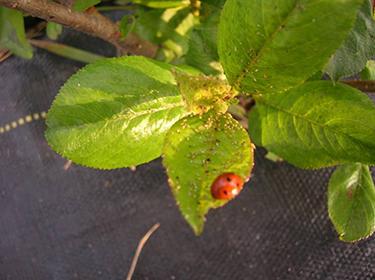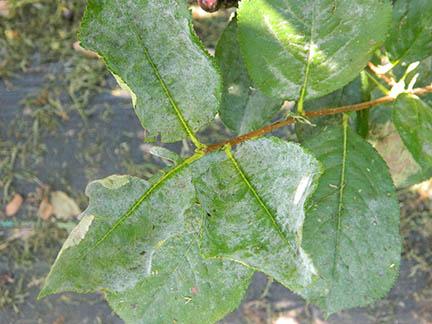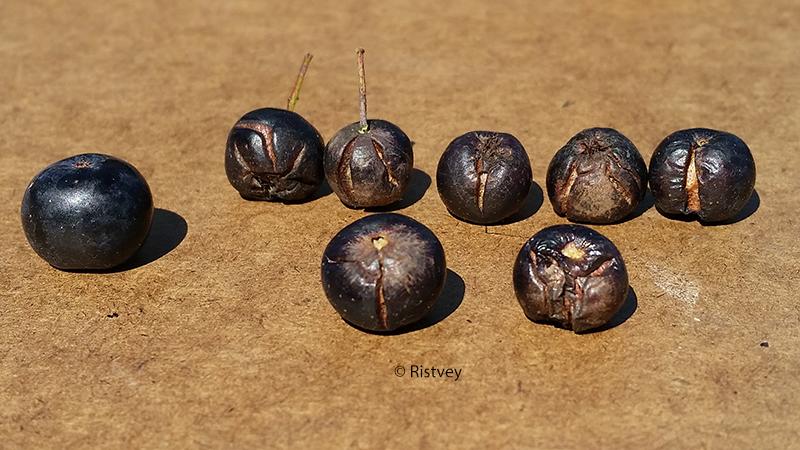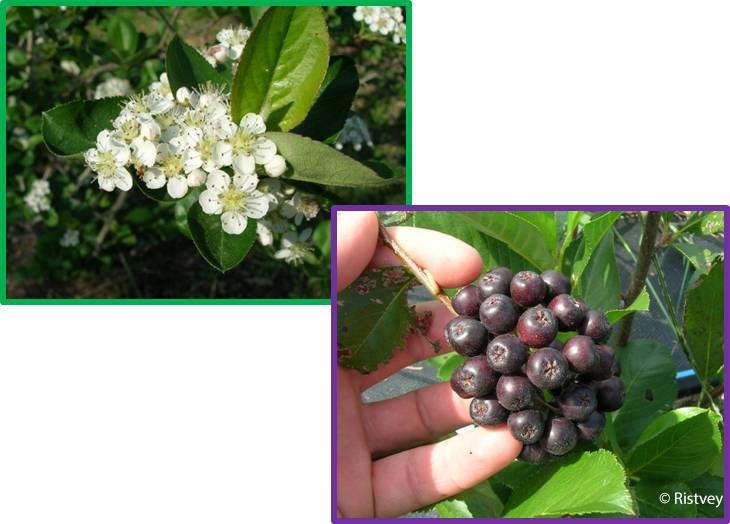While Aronia is a hardy plant, it does have a number of potential pest species that can have a large affect on plant health and fruit yield. Throughout the year, growers are encouraged to monitor their Aronia orchard to stay on top of possible insect, disease and other pest problems. For now, there are few control options that can be applied to Aronia, because of labeling. Some exist, but please inquire with the developers of this website to know which are available for Aronia. Aronia has been placed in the IR4 Group 13, subgroup 07B: Bushberry and Small Fruits. If a pesticide has this group labeled and the pest labeled, it is legal to use on Aronia.
Insects
Aphids are noted throughout the growing season feeding on the growing tips of the plant, but are usually controlled by predators like ladybird beetles and lacewings.

Blister beetles (Lytta sp.) have been found eating Aronia flower buds one week before flower peak. Since flowers are set the previous fall season, this equates to a loss of yield. In the past blister beetles have left within 4 days after arrival, leaving about a 5% loss in yield.

Cherry Fruitworm (Grapholita packardi), a lepidopteran (butterfly/moth) larvae has been noted for the past two years feeding inside the fruit. Less than 5% of the fruit has been damaged annually. The life cycle of this insect is known and organic control should be possible. If adults are noted in May, spray for larvae during the first week of June. The larvae reside inside the fruit throughout the growing season and emerge about about harvest time. This picture was taken after washing the fruit. The larva was coming out of the fruit.

Brown Marmorated Stink Bug (Halyomorpha halys) was seen feeding on fruit as early as June. Since 2011, damage from BSMB occured on less than 5% of the fruit. Ongoing research is looking at control options, but until now, few exist.
Japanese Beetle (Popillia japonica) is present from mid-June through July. Monitor orchard throughout this time period as often as possible. Beeltles rapidly consume foliage and fruit and can have a major detrimental affect on yield. Organc control methods are available.

Spotted Wing Drosophilla is a relatvely new fruit fly pest. This fruit fly is difficult to identify, and only males have the spotted wings. Females have an ovipositor (egg-laying mechanism) that can cut through fruit flesh, so fresh fruit can be infested. Some anecdotal evidence and some unpublished research has shown Aronia to be susceptable. The Aronia orchard at Wye REC has been monitored since 2013 for this fly. No infestations were noted.
Lace bug is a pest that occurs occasionally on Aronia. It can be controlled with dormant oil in the spring while the first generation is developing. Better control in the spring means less pesticides in the summer.
Japanese Maple Scale has been noted in several orchards last summer. This pest needs to be controlled early and should not be allowed to infest orchards. Control by dormant oil before bud break in spring when temperaitures are above 55 degrees F and above freezing for at least 3 days after application. Several sprays are required throughout spring.
Disease
At present, only one disease, Gymnosporangium spp. (e.g. Quince Rust or Cedar/Apple Rust) is has infected plants at the Wye Research orchard. In the past, infections are minimal and fruit that are infected are usually aborted. In the past years the infections have matured before fruit abortion and have moved into stem tissues. Infections however, continue to be minimal and all are removed from the plants by hand.
Powdery Mildew is a group of fungi that cause white or gray powdery spots or patches on leaves, flowers and fruit. It usually occurs when temperatures and humidity are high. Infected leaves will drop off and near complete defoliation can occur. This is detrimental for fruit production. Monitor at beginning of June, throughout summer. Control can be with various fungicides and organic controls like potassium bicarbonate.


During the 2016 growing season, a new and potentially destructive fungus was identified on aronia orchards at Wye Research and Education Center. Fusicladium, a scab disease was identified on fruit and leaves. Pictures below show infections in July progressing to harvest time. A brown lesion is seen on fruit which later, cause skin cracking, completely damaging fruit and making it unsalable. At this time cultural management is through sanitation during the fall. Leaves, containing spores that may infect fruit next season. Fallen leaves should either be collected or mulched for quick decay. No recommendations for chemical sprays can be made until the species is identified.

Other Pests
Deer are one of the larger problems associated with grower Aronia. The most effective deterent is a fence. Deer primarily eat dormant flower buds in winter, but damage has been noted throughout the year. Rabbits will cut stems off of small plants but as plants grow past 24" in height, problems discontinue. In the mid-west, bird predation on the fruit has been suggested but this has not been a problem in the Mid-Atlantic to this date.









